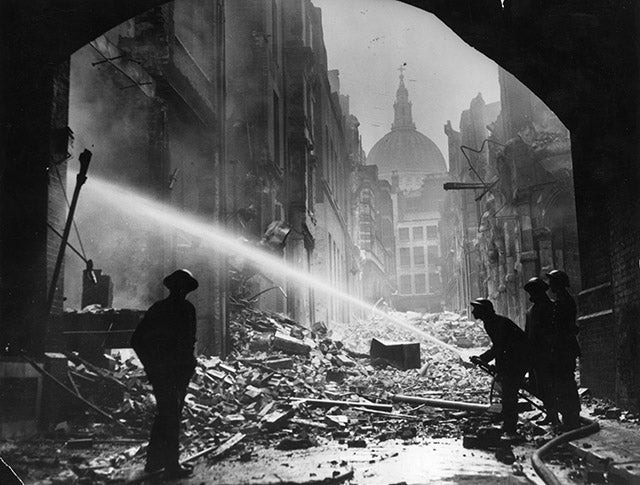By now there was no way the Allies hadn't become aware of our massive buildup in our small North American holdings, further aided by Canadian intelligence, this attack would not be the surprise of Barbarossa. The Allied High Command learned concurrently the knowledge of our preparations and the knowledge that an Allied 'victory' was impossible, the best they could hope for was pushing us off the continent, even then where would they go from there? An invasion of fortress Europe was out of the question for decades, and what would stop us from bombing North America into oblivion with our new weapon? However, what is equally unlikely as an American victory was an unconditional surrender without a fight. Despite their bleak situation, they continue to churn out propaganda posters faster than they produce cheap Shermans, simple prey for our Tigers.
The Kreigsmarine vs. The USN: First Contact.
On the 29th of January 1946, our fleets met for the first time, for a short and small engagement. Unbeknownst to us at the time, the American's were at an extreme disadvantage, it was underestimated exactly how technologically inferior their fleets were to ours. Their fleet was larger, just barley, it contained battleships, while our
2. Tragerflotte contained none, they were particularly worthless in this engagement. Our carriers were at least twice the tonnage and size of their American counterparts, allowing us to engage the entirety of their fleet --battleships and carriers alike-- with CAG's to spare. No decisive hits were scored but their fleet took mild damage, hopefully this shows how future naval battles will go.
Our first naval encounter.
The next few months were uneventful, a slow and mild front against the Italians in Africa, the completion of our new industrial capacity, and tedious shipments of supplies and troops to North America. The silence broke in late June 1946, in the Afternoon of the 28th, major offensives against the Americans in East Africa began, in coordination with the Italians who launched more numerous small scale attacks against them from the north in Ethiopia. These offensives went surprisingly well, we even predicted a crushing defeat. Perhaps this success was attributed to our new divisions designed specifically to counter the massive amount of U.S mechanized divisions:
Panzergrenadier Div.
- 1 Mechanized brigade.
- 2x. TD brigade, equiped with Jagdtigers, Jagdpanthers and Jagdpanther II's.
- 1x SP Rocket artillery.
Crushing victories.
Final Preparations.
June 30th, 1946, our Generals and Field Marshals went over their plans on last time before the invasion would begin, the date was set by the Fuhrer himself: July 4th, Independence Day. He claimed it would be "Ironic" and the day would be remembered in history as a replacement of the American Holiday. Commander of the operation, Reichmarshal Erwin Rommel, met the troops one last time, the propaganda ministry took advantage of the event: The highest ranking officer in the entire Reich meeting with thousands of the lowest, this only served to increase his popularity with the people.
53 year old Erwin Rommel meeting his troops.
After Rommel's charismic speeches, the stage was set, our guns were cleaned and loaded, our moral at an all time high, and above all, our minds sharpened. Our Korps were layed out to the beaches they would be storming:
- Southern landing, Washington D.C: I. Marineinf.korps
- Middle landing, (Remains) New York: II. Marineinf.korps
- Northern landing, Boston: XXV. Armeekorps (5 SS Divisions)
- Airborne landings: I. Fallschirmjagerkorps, II. Fallschirmjagerkorps.
- Reserve: XXIV. Armeekorps
July 4th, 7:00
Early naval landings.
The landings began at dawn, every one of them unopposed, the real challenge would be Allied counter-attacks. Immediatly after our divisions organization was regained, we began our relentless march towards our objectives, Allied resistence was light, once in the cites the real battles began, however, this was no Stalingrad, and these cities fell within days considering their meager garrisons.
In the South, Washington D.C fell early, ahead of schedule, thats when the opportunity to cross the river to the south of the city unopposed presented itself, the leader of our elite SS-Korps assured the High Command that he was up to the task, and again, our advance was swift and deadly, lethal in fact to any amount of Allied troops met along the way. However, the strength of our SS-Korps was not great enough to take our 4th objective, the major Allied port and airbase to the south of D.C. Despite this, by the 10th of July, all of our phase I objectives have been met, the landings were complete, the door to the rest of America was open.
Our supply lines established.
The Oberkommando der Luftwaffe quickly set up air superiority from captured Allied airbases, we were lucky these are still intact. Air superiority quickly became
air supremacy when the gap between our technology and the Allies became apparent, endless wings of piston-engine fighters thrown into our jets were destroyed, planes dropped like flies. The USAAF is still believed to have a substantial amount of air wings, but it is negligible after they all but disappeared from the skies after evaluating their losses.
On the 20th of July, the second atomic bomb arrived in America for use of our strategic bombers, Field Marshal Von Manstein immedietly ordered the use of the Strategic weapon with permission of the Fuhrer, its target: Chicago. The Junkers Ju EF150 took off from its base in New York and dropped the bomb not much later. The United States of America would not last much longer at this rate.
I am joking


























